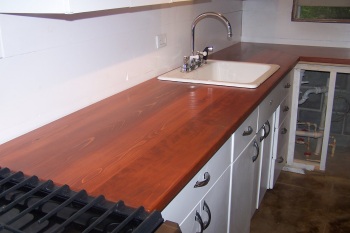Solid Wood Countertops
Advice on allowing for movement with solid wood countertops. October 13, 2010
Question
A customer wants a solid walnut countertop. Could I glue and biscuit join walnut planks together to form a 3/4" thick surface, and then screw that to a plywood substrate from the underside? Any problems with this method?
Forum Responses
(Cabinetmaking Forum)
From contributor J:
Big problems. The solid wood will shrink and expand with humidity changes. The plywood won't. The counter will self-destruct.
From contributor L:
I second the "bad idea."
From contributor E:
Why don't you just do a walnut butcher block 1 1/4" thick? We do a lot of them. Proper glue, true angles - might be the answer.
From the original questioner:
So it sounds like a bad idea. Thanks for the info. How about glue and biscuit joints with cleats on the bottom to help keep the planks more level? You know, like cleats on the back of plank doors. Problems?
From contributor R:
Planks? How wide? Good chance for cupping. I use hard maple, 7/8 to 1 inch thick, rip to 1 1/2" and glue up. More stable in my opinion, no cleats or sub boards to make it match the counters in the rest of the job.
From contributor N:
Just order the top from Boos. Walnut is a standard species for them. They buy wood by the trainload evidently, and the finished top will be about what you'd spend on the wood alone. And the warranty is theirs, not yours.
From contributor F:
Biscuits are at best unnecessary; they'll just add more work and time. Glue up your planks to the width needed. I've found generally thicker is better. Something as wide as a countertop I personally wouldn't go thinner than 1-1/4".
From contributor R:
I agree with the thickness. I glue up the wood on edge. So it looks more like a butcher block. Yep, a lot of work.
From contributor D:
Interestingly, I am signing some folks up today to make them about 26' of 25 1/2" countertops for a dining room, black walnut. Yes, you can do what you ask but how long is it and are there any finished ends? Just good edge joints and glue will be fine for your glue up. I looked at the option of ordering in butcher block looking tops, but to my eye, in the long runs I am working with, it looks like a bowling alley or butcher block, not a fine dining room with wider boards making each run. I am using 4/4 h&m at 15/16 for glue up.
From contributor P:
Is it for a kitchen? If so, construction is the easy part. Picking the right finish is the hard part. Glue up planks and connect the top using any method that allows for movement. The simplest is to use elongated holes in your stretchers and screws with washers or wide heads (a Kreg screw works fine).
From Professor Gene Wengert, Sawing and Drying Forum technical advisor:
I would like to add that biscuits are for positioning and do not add to the strength of an edge joint. Hence, they would not be needed, as already stated.
A metal frame underneath would work if and only if you use screws holes that are slotted, so that the screws can move in the slots as the wood shrinks and swells. Warping forces can be very large, so the frame must be strong.
From contributor B:
I do a lot of wood countertops. Here is a photo of a cypress top I built 8 years ago. The planks are about 6 inches wide. The photo is recent. The top finished out at 17/8" thick. I joined it with 3/8 inch glue pins, used an alcohol dye and put 5 coats of urethane on both sides (sprayed). I make a frame just like a set of face frames for cabinets and mount the frame to the top of the cabinets. I then route elongated holes in the frame and screw the top to the frame loosely so it can move. Been doing it this way for many years and have never had a failure.

From contributor Y:
8 years ago and the cabinets still aren't done? Must be your house right?
From contributor B:
Not my house. The people are doing an upgrade on their home (vacation home). We took the tops up and did a refinish job on their 1950's metal cabinets, buffed the tops and reinstalled them.
